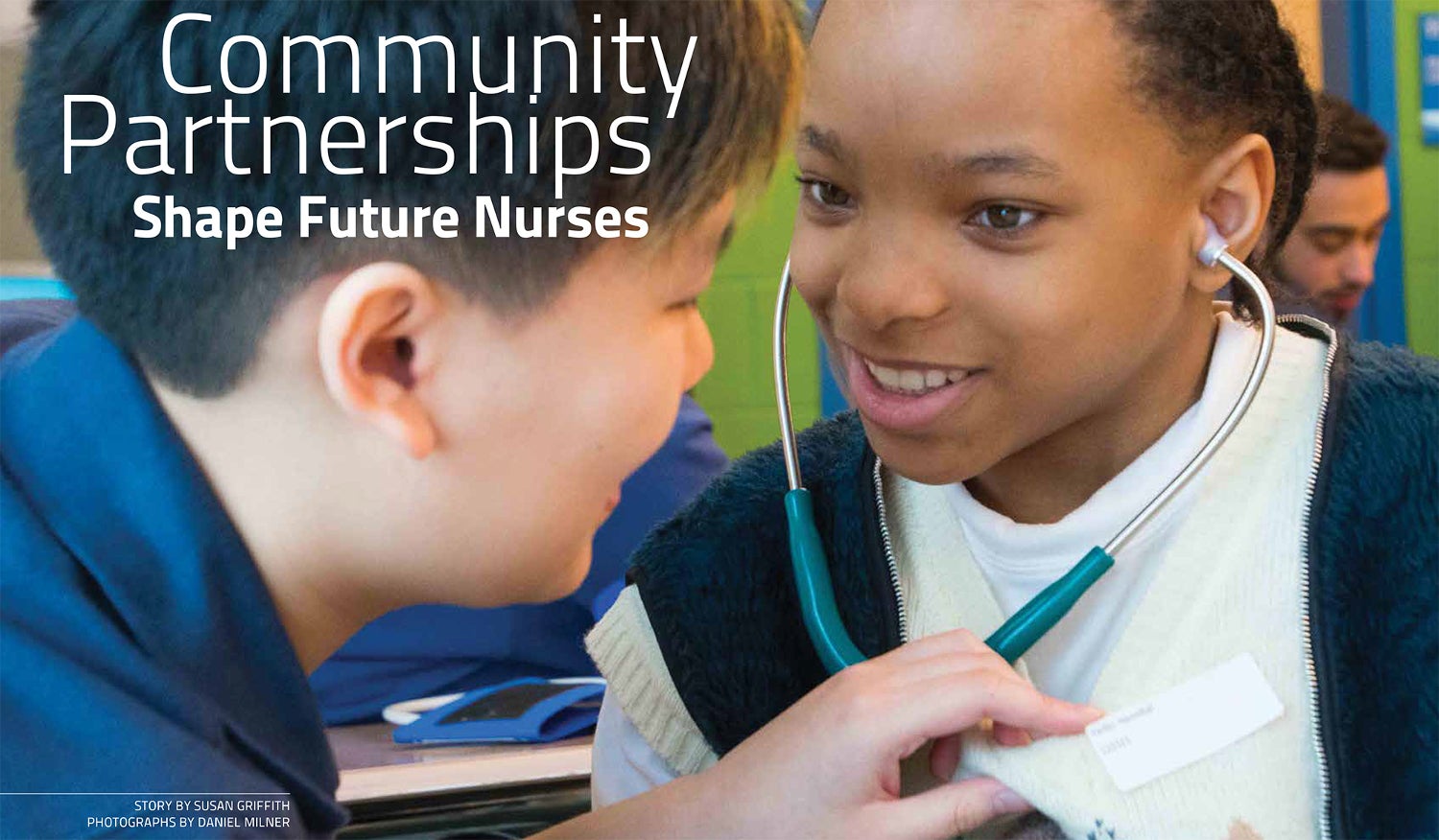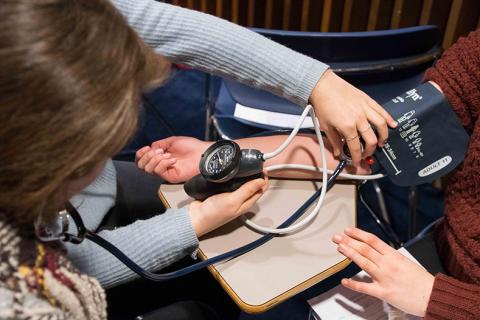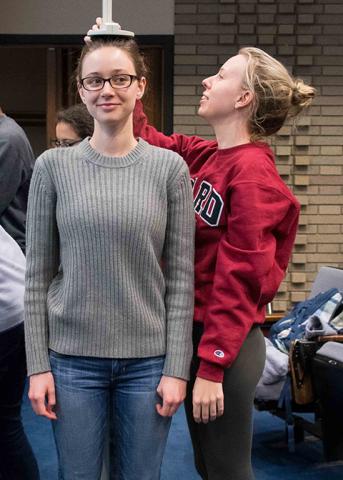BSN Students in the Community
By Susan Griffith
Photos by Daniel Milner
Undergraduate nursing students at Frances Payne Bolton School of Nursing have performed health screenings on approximately 40,000 Cleveland Metropolitan School District (CMSD) elementary schoolchildren since 2003. This unique partnership and service learning model is now a nationally lauded model for innovation in nursing education — recognized with the 2016 Centers for Disease Control and Prevention/the AACN Innovation in Baccalaureate and Graduate Population Health Curriculum Award.
GOOD HEALTH STARTS HERE
Jillian Balkenhol, a third-year undergraduate nursing student, greets the first fifth grader in line at George Washington Carver Elementary School. She asks his name, checks it off the list, gives him a sticker with his name and ID number, and then directs him to the first of three health screening stations.
The place buzzes with activity as the fifth grader makes his way through the three stations manned by second year student nurses who measure his weight, height, and blood pressure. At the blood pressure stop, he is challenged, like most of the children, to sit silently for five minutes, while his BP is checked three times.
The city school screening program is the largest project in Partners in Health initiative organized by the Frances Payne Bolton School of Nursing. Third-year nursing students, who have gone through the five course public health sequence in concert with second-year students, use the research quality equipment and follow specific protocols to complete the screenings.
Nursing students collect information, which school districts have been required to report to the state since the 1950s. The data has greater meaning now than ever, stresses Debbie Aloshen, MEd, RN, LSN, director of the CMSD Health and Nursing Services, “Kids are unhealthier now.” The numbers collected support her statement.
She reports kindergarteners used to be “square” — 34 inches tall and weighing 34 pounds. “Now, they are 34 inches tall and weighing 102 pounds. Their blood pressures are much higher, and Type II diabetes, which used to be an adult disease, is now found in the third grade.”
Of the children screened between 2010-15 for high blood pressure, up to two percent of the students were identified annually as hypertensive and were referred for medical care.
Parents receive the health findings in letters from the school to share with the family’s health care provider.
Aloshen explains that general, non-indentifying information about the student population is shared with sources, such as, the City of Cleveland, which uses the data to track health trends or to determine where additional community health care services are needed.
A PUBLIC HEALTH NECESSITY
The partnership between the CMSD and the Frances Payne Bolton School of Nursing began in 2002 after the American Association of Colleges of Nursing (AACN) urged nursing schools to demonstrate a linkage between the school and the health and wellness of the neighborhood residents.
Associate Professor Marilyn Lotas, PhD, RN, FAAN, then director of the undergraduate nursing program, saw a need even before this call to action, and responded by expanding the School of Nursing’s public health curriculum with new courses that combined class work with community experiences. Previously, the School of Nursing offered only one public health course in the senior year. “It was too little, too late,” she says.
The ultimate goal, says Lotas, is a nursing workforce that both reflects the population and understands cultural and community connections to health, and in turn, provides quality care in schools, clinics and hospitals for patients from diverse backgrounds that might differ from what students have experienced.
Lotas received a $10,000 planning grant from the Nord Family Foundation to organize a committee of experts from anthropology, informatics, epidemiology, medicine, and public health. Together they created and evaluated the proposed curriculum changes.
The program launched in 2003. It received help a few years later with a $75,000 grant from the St. Luke’s Foundation. In 2010, the School of Nursing received additional support in the form of a five-year, $500,000 Elisabeth Severance Prentiss Foundation grant, which helped expand the program by launching the district-wide screening program, and an asthma initiative in collaboration with the Cleveland Lung Association. Training included the Dreyfus Foundation’s Problem Solving for Better Health (PSBH), a framework that highlights how small changes help individuals and communities reach a positive, healthy outcome.
Students are taught screening protocols, including a training video to learn testing for accurate blood pressure reading. It also involved practice to insure that measurements were taken and recorded in a consistent manner.
FPB students visit schools on Friday mornings and afternoons. Sometimes they are joined by students from the School of Medicine. It is an interdisciplinary experience that teams nursing and medical students together to learn more about each profession.
‘DO THE REAL WORK’
“Measuring blood pressure, weight, and height are tasks nurses will do throughout their careers,” says third year student Balkenhol, who plans on a career in pediatric nursing and oversees the work of her younger classmates.
Margaret Kowalsky, a second-year student, who records measurements taken on the scale at the Carver School weight station, notes that this experience differs from their acute care hospital and clinical training. “Faculty are present, but we get to do the real work of accurately measuring weight, height, and blood pressures.”
The Cleveland Metropolitan School in-service learning opportunities reflect the FPB classroom learning, starting in the students’ first year, explains instructor Shannon Wong, CPNP, MSN, RN, the course coordinator for the Community Enhancement Engagement sequence.
Students begin in their first year with one course, “Healthcare in the Community.”
“Here,” Wong says, “Students are introduced to public health and have an opportunity to understand life outside the hospital or clinical setting. It’s actually ‘Case Western Reserve in the community.’ ”
They plan pilot projects and implement them. “We don’t expect them to move mountains in their first year. We want them to understand the community health connection,” says Wong.
During their second and the third years, they take courses including “Teaching/Learning in the Community,” “Evidence Based Public Policy in the Community,” “Leadership in the Community,” and “Process Change in the Community.”
Their second and third years are focused on the school screenings and health projects. Wong says that they
learn how to write teaching objectives for improving health in a community, design and implement a health project and evaluate their ability to teach and observe how their lessons are perceived and learned among the population.
She also notes that students have applied their classroom learning for health interventions at Westside Catholic Center, a homeless center, and McGregor Place Daycare Center for Older Adults. Students talk to and interview the centers’ clients to understand their needs and then design and test health behavior interventions targeted toward the clients’ needs.
The culmination of the course sequence is the Senior Capstone Project: a graduation requirement for all Case Western Reserve undergraduates. Teams of School of Nursing students develop and implement health projects at approved sites. “Our students learn the importance of how communities impact health. Faculty and students have contributed time and effort to help Cleveland’s organizations, like the Cleveland Metropolitan School District and the City of Cleveland. They work together to reduce major health issues like obesity, hypertension, and heart disease through health education programs. The student-designed interventions also provide steps toward a healthier and potentially longer life,” says Mary Terhaar, DNSc, RN, ANEF, FAAN, associate dean of academic affairs and the Arline H. and Curtis F. Garvin Professor of Nursing.
LEARNING LIFE LESSONS
Aloshen says FPB students augment health education in the CMSD. They help run a variety of educational programs like the American Lung Association’s Open Airways program for five high-risk public schools in Cleveland with a high number of children with asthma.
All are essential programs, Aloshen says, “but we don’t have enough time to address all of these health concerns.”
The nursing students help.
“Here students are introduced to public health and have an opportunity to understand life outside the hospital or clinical setting. It’s actually ‘Case Western Reserve in the community.’ ”
As part of her capstone project, FPB senior Shelby Means was a member of a team that taught district teachers and high school students to perform cardiopulmonary resuscitation (CPR) and use an automated external defibrillator (AED). The program was created to help Cleveland Metropolitan School District administrators comply with a new state law that mandated all graduating students have CPR/AED certification. Means and her teammates received instructor training for teaching CPR/AED from the American Red Cross.
“Our goal was to train as many students as possible,” says Means. “We were able to certify 280 students.”
Aloshen sees CMSD contributing to the education of future nurses as well. “The nursing students are exposed to the needs and challenges that our students face in their everyday lives,” explains Aloshen. “It’s one thing to see poverty on TV; it’s another to see a child walk into school without a coat, socks or underwear when it’s 15 degrees outside.”
FPB students also encounter many different cultures and witness how those cultures are blended and how to engage members the community.
Senior Ellen Swenson says by traveling to schools across Cleveland she learned how to talk to and calm anxious children during the screenings. “Some things you cannot learn from a Power Point presentation,” says Swenson who plans to become a pediatric nurse practitioner. “Experiential learning is the best way to learn.”
During her school visits, she notes she also had the opportunity to answer questions about being a nurse, talk to children about what they want to be when they grow up, and discuss the importance of school to realize those dreams.
“One of the biggest advantages of this partnership is that it shows our kids that there are places for them to go and be when they grow up,” says Aloshen. “The little kids are thrilled when they get a nursing student for the day. Their faces light up.”
The feeling is mutual.







